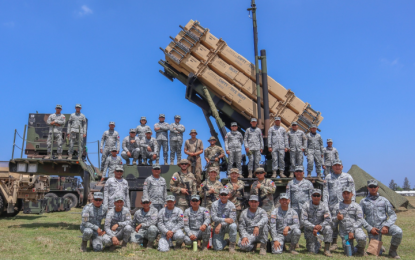960th Air and Missile Defense Group personnel pose with the 38th Air Defense Artillery Brigade, US Army and their missile launcher. (Photo courtesy of PAF)
MANILA – The Philippine Air Force (PAF) has been briefed on the operations and other specifications of the American-made MIM-104 Patriot surface-to-air missile system.
In a statement over the weekend, PAF spokesperson Col. Ma. Consuelo Castillo said it was made possible during the air and missile defense subject matter expert exchange (SMEE) conducted by the 38th Air Defense Artillery Brigade of the United States Army at Naval Education, Training and Doctrine Command in San Antonio, Zambales on April 19.
“During the learning session, subject matter experts from the 38th Air Defense Artillery Brigade discussed the operations, role, various specifications, capabilities, and key parts of the Patriot missile defense system involving the radar set, engagement control station, missile launchers, and the Patriot missile,” she said.
The Patriot is one of the premier missile systems of the United States and is classified as high to medium air defense system.
The SMEE is part of the ongoing “Balikatan” exercises which started April 11 and will end on the 28th.
PAF participants are from the 960th Air and Missile Defense Group (AMDG), the operator of the newly activated ground-based air defense system (GBADS) consisting of SPYDER medium-range missiles from Israel.
The first two GBADS batteries were commissioned and activated by the PAF on Nov. 8 last year.
“The aforementioned exercise broadened the understanding of the Air and Missile System Operators of 960th AMDG on air and missile defense operations. Likewise, it strengthened ties and comradery between the PAF and its US counterparts,” Castillo said.
GBADS, also known as the SPYDER Philippines Air Defense System, is a mobile air and missile defense system designed to protect critical installations, land-based fixed assets, mobile platforms, and friendly forces from aerial threats, such as combat aircraft, attack helicopters, unmanned air vehicles, incoming missiles, guided munition, and rockets.
In certain cases, it may also be used to neutralize surveillance threats.
The Philippines and Singapore are the only two countries in the Southeast Asian region operating the advanced missile system.
Castillo also said the GBADS is an acquisition project under Horizon 2 of the AFP Modernization Program.
The first two GBAD batteries were delivered on Sept. 24 and 29, 2022, while the third battery is expected on May 24, 2024.
A typical PAF GBADS battery consists of a command-and-control unit, three main firing units equipped with four missile launchers, along with two support vehicles for field service and munition resupply.
The GBADS contract is worth PHP6,846,750,000 and includes integrated logistics support, a simulator, a missile repair facility, and air defense systems missile training for personnel.
The Department of National Defense signed the GBADS contract with the Israel Ministry of Defense and the Rafael Advanced Defense System Ltd. on Sept. 23, 2019.
Meanwhile, the PAF’s 15th Strike Wing’s A-29B “Super Tucano” and the 17th Special Operation Squadron’s AC-130J of the US Air Force (USAF) carried out a live gunnery exercise at Col. Ernesto Ravina Air Base in Capas, Tarlac on April 21.
“The exercise was conducted as part of their close air support integration, with assistance from various aircraft controllers, including those from the PAF’s Direct Air Support Force of Air Defense Command, the Combat Air Controller Team of the 710th Special Operations Wing,” Castillo said.
The USAF’s Joint Terminal Attack Control of the 320th Special Tactics Squadron observed the entire exercise.

